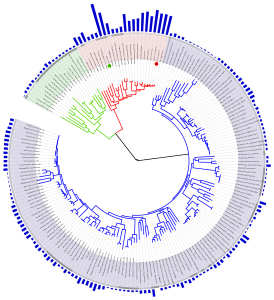

We believe that considering viruses alive or not is not just a matter of opinion, contrary to a commonly held view, but rather is a matter of inference and logic starting from any given definition of life
Following is my distillation of why the authors believe that viruses are not alive, and why they do not represent ancient lineages of the tree of life.
1. Viruses are not alive
Throughout history there have been many definitions of life. Viruses do not meet the criteria for any of them. They lack any form of energy, carbon metabolism, and cannot replicate or evolve. They are reproduced only within cells, and they also evolve within cells. Without cells, viruses are “inanimate complex organic matter”.
2. Viruses are polyphyletic
In a phylogenetic tree, the characteristics of members of taxa are inherited from previous ancestors. Viruses cannot be included in the tree of life because they do not share characteristics with cells, and no single gene is shared by all viruses or viral lineages. While cellular life has a single, common origin, viruses are polyphyletic – they have many evolutionary origins.
3. There are no ancestral viral lineages
No single gene has been identified that is shared by all viruses. There are common protein motifs in viral capsids, but these have likely come about through convergent evolution or horizontal gene transfer.
4. Because today’s viruses infect phylogenetically distant hosts doesn’t mean that they are ancient
It cannot be proven that early viruses appeared along with the first cells. The problem is that viruses move readily between diverse hosts. Consequently the ability of a virus to infect a particular species could lead to false conclusions about the ancient origin of viruses.
5. Viruses don’t have a structure derived from a common ancestor
Cells obtain membranes from other cells during cell division. According to this concept of ‘membrane heredity’, today’s cells have inherited membranes from the first cells that evolved, and provides evidence that cells are derived from a common ancestor. Viruses have no such inherited structure.
6. Viral metabolic genes originate from cells
Many viral genomes encode proteins involved in energy, carbon, and cellular metabolism. It has been argued that the presence of these genes indicates that viruses are ancestral to cells. Unfortunately, metabolic genes are not present in the ancestors of these viruses. This finding makes it difficult to argue that viruses predate cells.
7. Viral translation genes originate from cells
The mimivirus genome harbors genes encoding elements of the protein synthesis machinery. This observation has been interpreted to mean that viruses did not always rely on cells for translation. However, sequence analysis indicates that these genes are derived from cells by horizontal gene transfer.
8. Viruses steal genes from cells
Viral genomes encode many genes that have no homologues in cells. It has been suggested that viruses influence evolution of cells by donating new genes. Sequence analysis has failed to provide support for this hypothesis. Viruses are ‘gene robbers, not gene inventors and massive gene suppliers’.
9. Most gene transfer goes from viruses to cells
The movement of genes is mainly in the direction of cells to virus. Transfer in the reverse direction is minimal. Therefore viruses have not had a significant role in shaping the gene content of cells. This conclusion is paradoxical because viral genomes are the most abundant on earth.
10. Just because viruses are simple doesn’t mean that they are old
One view of evolution is that it is a process by which simple organisms become more complex. The simplicity of many viruses lead to their placement at the origin of life. This long-standing hypothesis ignores the fact that viral genomes are subject to selective pressure to maintain minimal size to ensure rapid replication rates. The authors conclude that viral simplicity is a consequence of parasitism, not antiquity.
Even though viruses are not living and should not be included in the tree of life, they play an important role in evolution of their cellular hosts by regulating population and biodiversity.
Are you convinced by these arguments? Post a comment and let us know whether you think viruses or living or not.
Moreira, D., & López-GarcÃa, P. (2009). Ten reasons to exclude viruses from the tree of life Nature Reviews Microbiology, 7 (4), 306-311 DOI: 10.1038/nrmicro2108

life… that which grows larger an heavier or smaller and lighter or both, e.g. pregnancy/birth.
inanimacy… that which gets larger and lighter or smaller and heavier or both e.g. supernovae.
Best,
J.